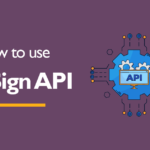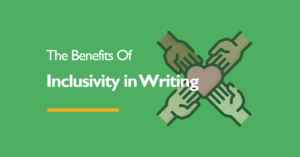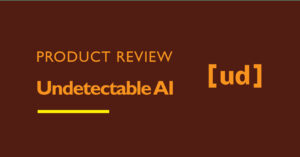A few months back, my niece was going through the book collection in my living room while I worked on some personal projects in my study.
Just as I was about to take my first break, she popped into my study and blurted out: “Uncle, why is it a man’s world?”
I froze. Of course, it’s not technically a world exclusively for men, I thought. But hearing that question from a young girl put things into a fresh perspective.
Even though the writer meant no harm with such a throwaway statement, the confusion on my niece’s face said otherwise.
As an advocate of inclusive writing, let me share my thoughts on how not to alienate your audience.
What is inclusive writing?
Inclusive writing is the act of creating written content that resonates with every member of your audience without discrimination, harmful stereotypes, or gendered words.
In modern writing, inclusivity goes beyond long prose; it also bleeds into UX copy, corporate messaging, copywriting, and advertising.
Every piece of writing should follow DEI (diversity, equity, inclusivity) principles.
Why? Because DEI is necessary if you don’t want to alienate segments of your audience despite what some people would have you believe.
What causes a lack of inclusivity in writing?
The main reason why people don’t use inclusive language in writing is because of social factors.
If you come from a background that pays little attention to sensitivity and subtlety in language, inclusivity would sound foreign to you.
We also fall into the trap of not evolving with the times. Some of us still use expressions like “businessman” and “countryman” as universal qualifiers.
This kind of language is dated and could alienate 50% of your target audience—the people who are not in a man’s world.
Why is inclusivity important in writing?
Using inclusive language in your written communication is essential for various reasons:
- It protects you from legal trouble.
- It keeps you from hurting people’s sensibilities.
- It shows that you are empathetic and self-aware.
- It makes the reading experience pleasurable for everyone.
- It makes it easy for people with disabilities to feel represented.
- It helps you acknowledge your inherent biases and misconceptions.
- It shows Google that your content doesn’t use dated or hurtful language.
- It shows readers that you are aware of changes in language and expression.
- It shows readers that you are in tune with differences, cultures, and experiences.
How to make your writing inclusive
If you don’t want to offend readers with your word choice, here are some things to do when writing.
Make it accessible
Accessible language appears in two forms. The first definition of accessibility points to the use of clear sentence construction and text formatting to make the text readable to everybody.
Use clearly constructed headers and bulleted lists to make the text skimmable. Then, make sure the font is legible for web and print. Hyperlinks and important information also need to stand out on the page.
Accessible writing will help people with reading difficulty assimilate the text, even if they are using digital screen readers.
Avoid gendered words
The most controversial gendered words are the pronouns “he/him” and “her/she”. In the formal or corporate setting, you need to address people how they want to be addressed.
No need sticking to your guns when someone tells you their preferred pronouns. If you don’t know the gender of the person, just use the gender-neutral “they/them”. Better still, address them by their given name. When in doubt, always ask.
Bad: The final decision depends on him or her.
Good: This final decision depends on them.
Apart from pronouns, you need to remove gendered expressions from your vocabulary and replace them with gender-neutral alternatives.
Bad: The policewoman took it like a man instead of crying like a girl.
Good: The police officer braved the injury.
Be subtle about disability
Your words should not make people with disabilities feel ‘labeled’ or part of an out-group. Don’t make someone’s disability their entire persona.
Bad: The crazy pop singer is a schizophrenic.
Good: The pop singer has mental health conditions.
Good: The pop singer has schizophrenia.
While showing empathy for people with disabilities, don’t paint them as victims—and don’t refer to the disability as an illness or weakness.
Bad: The man over there suffers from speech impediment.
Good: The man over there has a speech impediment.
Disabilities like blindness and deafness entered the lexicon centuries ago as pejoratives. This era wasn’t known for subtlety and inclusivity in language.
So you should never call people “dumb”, “blind”, and “crazy” in casual communication. These words are offensive and ableist.
Bad: The advice I gave him fell on deaf ears.
Good: He did not heed my advice.
If the disability is not visible and adds nothing to the point you’re making, leave it out of your writing.
Avoid generalization
When writing for a heterogeneous audience, avoid sweeping generalizations that assume every individual in the group is the same.
Besides, generalization opens the door for stereotypes. Even if it’s a running joke, keep it away from your writing.
Bad: Women are unpredictable.
Good: Humans are unpredictable.
Be careful with old words and phrases
As mentioned earlier, some old words and phrases from the biblical or Shakespearean times may be too dated for a modern audience.
Bad: Unbeknownst to him, the weather had changed since morning.
Good: He didn’t know the weather had changed since morning.
These phrases are technically correct, but younger people and non-native English speakers might struggle to understand them.
Get rid of slang and jargon
When writing as experts, we feel the urge to weave in industry jargon to signal our expertise to readers. But for the broader audience, sifting through jargon-filled content is a chore they’d rather avoid.
Bad: The prescription management solution complies with FDA regulations.
Good: The prescription management solution complies with FDA (Food and Drug Administration) regulations.
If the use of jargon is unavoidable — such as with acronyms and abbreviations — you have to explain the terms whenever they appear first.
Be mindful of race, sexuality, ethnicity, and nationality
Don’t guess people’s ethnicity, nationality, or race based on their appearance. When in doubt, ask the person or confirm from a reputable source.
When writing about racial topics, be mindful of dated terms that might be pejorative and no longer acceptable in polite society.
Bad: The new CEO is black.
Good: The new CEO is a person of color.
You must also ascribe the correct nationality or ethnicity to the person you’re addressing. To you, this might seem inconsequential. To the other person, it might be a traumatic experience.
This also extends to names of places as well as other easily confused terms, such as referring to an African as “African American”.
Bad: The lady from Kiev looks a bit Russian.
Good: The lady from Kyiv looks Eastern European (or Slavic).
Bad: Anthony Joshua is an African-American boxing world champion.
Good: Anthony Joshua is a British-Nigerian boxing world champion.
When referring to someone’s sexuality, be careful not to put the person into a victim class or narrow down their existence to their sexual orientation.
Bad: John’s sexual preference shows me that he is part of a minority.
Good: John’s sexual orientation shows me that he is part of an underrepresented class.
Pay attention to religious differences
As part of not making assumptions, be careful when labeling people as part of any religion or faith based on nationality.
Bad: Nigeria is a Muslim country.
Good: Nigeria has a significant Muslim population.
Despite misconceptions, only half of Nigeria’s population practice Islam.
You also need to differentiate ethnicity from religion. Someone can be Jewish but not a practitioner of Judaism.
Also, don’t use religious greetings in a non-religious setting. Although some countries with religious homogeneity allow such greetings, always be mindful when addressing a broader audience.
Bad: Happy Easter to you and your loved ones.
Good: Happy holidays to you and your loved ones.
Don’t be patronizing
Avoid patronizing language like “inspirational” and “strong” when describing people with disabilities or underrepresented groups.
People want to be treated as normal, regardless of their condition and position in life. So unless the person or group in question does something truly inspirational, try not to frame their condition as brave.
Key takeaways
- Using the right words can make your writing inclusive and welcoming to readers from different backgrounds and social statuses.
- Some of these changes to language can take time to master. But you can make your writing by practicing, asking questions, and staying updated with style guides.
- When in doubt, always use gender-neutral alternatives for gendered words and pronouns.
Want to make your writing inclusive? Contact us at RoninPoint, and we’ll help you out.
Who wrote this?
Ugochukwu Ezenduka writes about technology with the flair of a fiction writer for Ronin Point and other companies. He knows his way around JavaScript, ReactJS, and other programming languages. With a Master's Degree in Engineering, Ugochukwu has the chops and experience to break down complex concepts in digestible language. When he is not writing about tech, you can find Ugochukwu kicking a football or traveling with his camera.
- Ugochukwu Ezendukahttps://roninpoint.com/author/roninpoint/
- Ugochukwu Ezendukahttps://roninpoint.com/author/roninpoint/July 25, 2024
- Ugochukwu Ezendukahttps://roninpoint.com/author/roninpoint/June 10, 2024
- Ugochukwu Ezendukahttps://roninpoint.com/author/roninpoint/February 13, 2024










1 thought on “Inclusive Writing: How to Write For Everybody”
thank for sharing, learned so much from this article